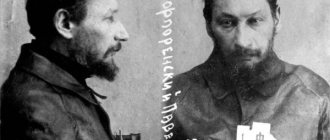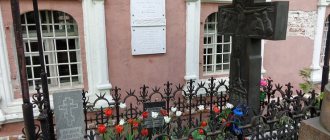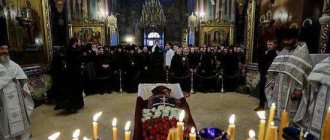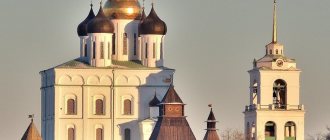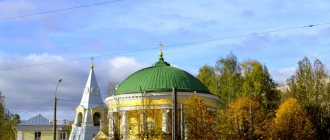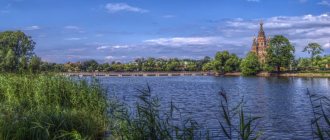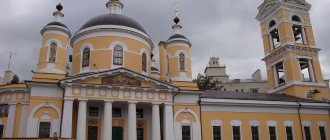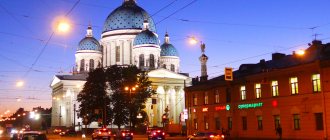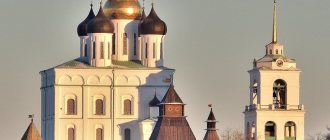Inside the Trinity-Sergius Monastery, in some places there are still forests, around them, like bees, workers scurry back and forth in neat dark blue overalls with the inscription “Baltstroy”, the Trinity Cathedral, wrapped in nets, is not yet open to view in its full beauty pilgrims and sightseers. Those who come here for the first time are surprised by how many people crowd at its entrance; seasoned people know well that this is the queue to the relics of St. Sergius. Sometimes the human tail becomes so long that it reaches the Spiritual Church...
How difficult it is to talk about the Holy Trinity Sergius Lavra! The Lavra has many faces, voluminous volumes of dissertations and scientific works have been published about it and its incarnations. And how many personal impressions of the visit have been written! But I also have so many impressions that I irresistibly want to add my own modest touches to the portrait of this place. A place that has long been revered and loved by Russian people. A place now again diligently visited by thousands of our compatriots.
Well, let's move on together?
At the masterpiece of ancient Russian architecture
We walk along the textured, somewhat unusual, interesting paving stones, we hurry along the green alley to the Trinity Cathedral - the oldest on the territory of the Trinity-Sergius Lavra. The white stone temple is the second one standing on this site. The first, cut down by the hands of Sergius of Radonezh himself, was burned by the Tatars during the raid of Khan Edigei at the beginning of the 15th century.
Remember, Nesterov’s textbook paintings: discreet northern nature, impenetrable forests, Mount Makovets, the monk feeding bread from his hands to a huge bear, The year is 1337 from the birth of Christ... With hard work, with his own hands, Sergius erects a small wooden church...
The church was consecrated in honor of the Holy Trinity. That's how I am. I heard it and turned a deaf ear. Friends, have you ever wondered why the church was named after the Trinity? Just?
It turns out that everything here is not at all simple.
Trinity-Sergius Lavra - the spiritual monastery of the Russian Church
Not far from Moscow, in the city of Sergiev Posad, there is the largest Orthodox monastery in Russia. Its church name is Holy Trinity Sergius Lavra. Created almost seven centuries ago, today it is the educational center of the Russian Orthodox Church. One of its cathedrals houses the relics of the founder of the Lavra, the spiritual ascetic of all Rus' - Sergius of Radonezh.
Trinity symbolism
A thousand years ago, the irreparable happened: the edifice of Christianity, which seemed unshakable, split. And on its ruins the first two branches sprouted - Orthodoxy and Catholicism. And the paths of the Eastern and Western churches diverged forever.
But what remains between them is the commonality - faith in one God, who created the world and man living in it. And all Christian denominations firmly know that the one God is at the same time a consubstantial Trinity, represented in the hypostases of God the Father, God the Son and God the Holy Spirit. Like the sun, consisting of a solar circle, light and heat. For any Christian, this is a symbol of love and unity.
The time of the reverend’s life was a difficult time, when endless civil strife destroyed the country, only a common faith united people.
If unity of command reigns in Catholicism, then the soul of Orthodoxy is conciliarity. And it exists in the image and likeness of the unity of the Holy Trinity.
The Great Sergius, gathering Russian people together in those distant times, taught life together, unification in the face of common difficulties and problems, joint defense of their fatherland. He laid the conciliar principle in the deep foundations of our national character. And this is something with which you can overcome any moral split in society and begin the path of national revival.
That is why the righteous man and prophet Sergius dedicated his temple to the Trinity - “in order to conquer hated discord by looking at it.”
The Trinity, consubstantial and indivisible, reflected in countless churches and icons, became for ancient Rus' a symbol of the unity of the country, the spiritual community of the people, mutual love, and readiness for self-sacrifice.
Humiliated, bloodless, groaning under the foreign yoke, the country gradually began to rise from its knees; it had a long and difficult path ahead, with brilliant victories and bitter defeats.
Bell tower, the high-rise dominant of the monastery
To the north of the monument about its own heroic history, the Trinity of Sergius Lavra is shaded by its tallest structure. Initially, the belfry was supposed to be three-tiered, which is how the court architects Schumacher and Michurin saw it. Dmitry Ukhtomsky, who studied with Michurin and inherited the position of chief architect of Moscow, was entrusted with carrying out his own project. He increased the height of the structure to almost 88 meters, surpassing the bell tower of Ivan the Great by 6 meters. The decorations were forced to be simplified against those proposed.
Nevertheless, the bell tower of the Trinity Lavra of Sergius was remarkable in all respects. It’s not for nothing that three decades have passed since the decision to build it and the performers have changed. A solid quadrangle, visually lightened by pilasters, is crowned by four smaller tiers. They are decorated with paired columns with small porticoes, decorated with vases in the corners. Open openings and narrowing contours create the impression of airy lightness. The unusual completion of the bell tower looks colorful, and not only due to the gilding.
The closest neighborhood is the tomb of the Godunovs
Less than twenty meters separate the Godunovs’ tomb from the bell tower, where the remains of the tragic king and his family rest. The building, which has an unusual appearance, was erected in 1782, much later than the sudden death of Boris Fedorovich. The naturalness of his death has been questioned, but no malicious intent has been proven. In the same way, Godunov was suspected of eliminating Tsarevich Dmitry, the youngest son of Ivan the Terrible. The appearance of doubles of the deceased heir to the throne was predetermined; the Time of Troubles broke out.
How the Trinity of Sergius Lavra manifested itself during this period was already noted in the review and immortalized by the monument. At the same time, the reasons for the burial of the Godunov family here are not entirely clear. However, 13 years of regency plus 7 years of rule after legal election (although there were doubters) is a lot for Russia. But let’s not bother with historical mysteries, the answers to which we cannot give. The tomb stands at the main entrance to the largest temple on the territory of the oldest monastery, and does not disturb anyone.
Living river of Russian history
Today's golden-domed and white-stone cathedral was rebuilt by Sergius' disciple, St. Nikon, in 1422.
Stone-reliable, it is, at the same time, directed upward and airy. Majestically beautiful, but at the same time very modestly decorated - only a belt of three ribbons of carved ornament surrounds it.
During the construction of the Trinity Cathedral, the monks miraculously found the incorrupt relics of St. Sergius of Radonezh, which became the main shrine of this temple, the main shrine of the entire Trinity-Sergius Lavra, one of the most significant shrines of all Orthodoxy.
Over the centuries that have passed since the death of Sergius, the world has changed, almost all material evidence of that era has disappeared, but the feelings to which believers come to the tomb of the monk have remained unchanged - pain, joy, hope, gratitude for help.
Every morning, at half past five, for many centuries, monks in long black robes and hoods gather here for an akathist to the saint, singing majestically and strictly. Then time disappears, and you are caught up in the living stream of Russian history.
Bell tower of the Lavra
Bell tower of the Lavra, years of construction - from 1741 to 1768. The height of the Trinity-Sergius belfry is 88 meters, it was built according to the design of the architect D. V. Ukhtomsky. The five-tiered bell tower is considered the most beautiful in Russia. Here is the largest, weighing more than 70 tons, the Tsar Bell. The restoration of the belfry was carried out only in 2014, on the eve of the celebration of the 700th anniversary of St. Sergius.
Nowhere else in the world
In their reviews, people who attended the liturgy under the arches of the Trinity Cathedral write enthusiastically about the unique and sublime mood they received; it is created among those present by ancient spiritual melodies, performed in the special singing tradition of the Trinity-Sergius Monastery.
The special cathedral where the relics of St. Sergius are kept requires special church hymns. Monks and novices revived the lost tradition of “znamenny chant” in worship, as the most appropriate to the ancient shrine.
Inside the ancient Trinity Cathedral of the Sergius Lavra there is twilight. The light from the narrow windows of the dome drum, without reaching the floor, softly diffuses into the heights. Silence... There are frescoes on the walls. But, alas, these are no longer paintings from the 15th century; a very small fragment of them has been preserved in the altar. The rest, due to its disrepair, was knocked down in the 17th century.
Below, under a silver canopy on four pillars, there is a chased, also silver shrine, in which the holy of holies of the cathedral is kept.
Troubles
Why is there a hole in the side gate of Trinity Church? Why won't they fix it? Because it's memory. A cannonball hit the gate. This happened during the Time of Troubles, at the beginning of the seventeenth century.
The Time of Troubles is when one dynasty of Russian princes and tsars was interrupted, and another has not yet appeared. Russia was left without a strong government. Princes and kings were constantly changing on the throne, various impostors appeared who wanted to illegally take the throne...
So Emperor Vasily Ivanovich Shuisky sat on the throne. The Russian Church recognized him. And the Trinity-Sergius Monastery supported the king. But near Moscow, in Tushino, the impostor False Dmitry II stood with a large army. He pretended to be a legitimate prince, the son of Ivan the Terrible, who was actually killed in childhood. A variety of people served in the army of False Dmitry: fugitive Cossacks, traitorous nobles, Poles, Lithuanians... Everyone wanted to distinguish themselves and receive awards and honors from the false prince.
False Dmitry decided to attack the Trinity-Sergius Monastery. For what? If he had captured the monastery, he would have easily surrounded Moscow and quickly smashed Shuisky’s defenses. But the main thing is that the impostor understood: if he was supported in the monastery of St. Sergius, it would be easy for him to seize power in the country! And the Polish lords and Cossack atamans, who were next to False Dmitry, dreamed not so much of power as of treasures: they thought that they would rob the monastery and get a lot of money.
The troops of False Dmitry, under the control of the Polish-Lithuanian hetman Jan Sapieha and Pan Alexander Lisovsky, besieged the monastery of Sergius of Radonezh for more than a year - from October 1608 to January 1610. What does “besieged” mean? This means - they stood under the walls of the monastery, did not allow anyone to enter or leave, they starved everyone who was in the monastery, fired at them, tried to undermine them and from time to time stormed them. And everyone was waiting for the defenders to surrender.
Inside the monastery walls, only two to three thousand people could hold weapons: monks, archers, several experienced military leaders from the nobility and peasants from the surrounding villages. And there were several times more enemies outside! Against each defender of the monastery there were from four to seven enemy warriors! True, the Lavra had excellent guns. The kind that Sapega and Lisovsky could only dream of.
False Dmitry hoped that the defenders of the Lavra would not risk their lives for Tsar Vasily, but would quickly recognize the impostor as the legitimate ruler and give him the treasury. But the defense participants were not going to give up! The ranks of the defenders were melting. People died from hunger and wounds. By the summer of 1609, out of three hundred monks, there were only forty left in the monastery, and no more than two hundred warriors capable of fighting. Reinforcements could not break into the monastery. It was during these terrible days that a cannonball struck the door of the Trinity Church - right during the service.
Many of ours were killed, but even more of our enemies! Streltsy detachments attacked them as they got out of the monastery. Artillery fired from the monastery walls, warriors showered the enemy with lead. The troops of Vasily Shuisky supported from the outside. Every day there were skirmishes and battles. The Lithuanians and Poles tried to dig a passage under the walls, but it didn’t work out... The soldiers of False Dmitry were exhausted and tired.
On August 7, 1609, the enemies nevertheless decided to launch a big assault. Sapieha's army was confident of victory, and two hundred defenders of the monastery, hungry, wounded, and weakened, were preparing for death. And suddenly... the attackers themselves began to beat each other! How so? It turns out that foreign soldiers heard their allies speaking Russian in the darkness of the night, decided that it was the enemy, got confused in the signals and... attacked their own! And from the Trinity Monastery they were all showered with cannonballs from the monastery cannons! Hooray! The assault has failed! And a large army of Prince Skopin-Shuisky, a supporter of Tsar Vasily, was already rushing to the aid of the monks! Will the siege end?
Yes! As the chronicler wrote, on January 12, 1610, “...hetman Sapega and Lisovsky, with all the Polish and Lithuanian people and with the Russian traitors, ran to Dmitrov, persecuted by no one, only by the right hand of God. They fled in such horror that they did not wait for each other, and abandoned their supplies. And many after them found great wealth on the roads - not the worst things, but gold, and silver, and expensive clothes, and horses.”
Lavra survived! The enemy has fled! And our people believed in themselves. The steadfastness and courage of the defenders of the monastery of St. Sergius of Radonezh gave them hope that the enemy could be defeated!
Just two years later, forces gathered around the Trinity-Sergius Lavra that helped the militia of Minin and Pozharsky reach Moscow and put an end to the Troubles. And the participants in the defense of the monastery later admitted that during the siege at night they saw the Monk Sergius himself on the wall, walking around his monastery with prayer.
Who got an A in history?
Of course, for those who had history as their favorite subject, I will not say anything new. Although it is always useful to delve into your memory and refresh your knowledge.
The Grand Duke of Moscow and the first Russian Tsar, Ivan the Terrible, is certainly a well-known personality in Russian history. They say that the personality is complex and contradictory. So contradictory that she, this person, did not even exist in nature.
And there were five different kings, who, they say, differed from each other so slightly that they subsequently merged into a single image of a non-existent person. Yes! And there was no Tatar-Mongol yoke either! Well, like Bulgakov - what is it, no matter what you miss, there’s nothing.
But, although there are gentlemen who are diligently shaking the foundations of historical science, it still stands indestructible.
This means, until the contrary is proven, there was Ivan Vasilyevich in the world - the eldest son of Vasily III and the beautiful Elena Glinskaya, the grandson of Ivan III and Sophia Paleologus, the niece of the last Byzantine emperor. It was she, Sophia, who brought with her a rich library with ancient manuscripts. However, the legendary book treasury one day disappeared into some unknown place, and enthusiasts are still looking for it.
The father of the future Ivan IV, Grand Duke Vasily III, was in a happy marriage with Solomonia Saburova for more than twenty years. Complete harmony was hindered only by the lack of heirs. No matter how much the spouses prayed to God, no matter how much they traveled to monasteries, went on pilgrimages, no matter how generous they made donations, it did not help.
The middle-aged Grand Duke then takes a decisive step. The unfortunate Solomonia, despite her resistance, is tonsured a nun. And the dazzlingly beautiful sixteen-year-old Princess Elena Vasilievna Glinskaya sits in the vacant seat of the Grand Duchess.
However, the newlyweds did not receive an heir until four long years later. A son was born. There was rejoicing throughout the whole country: cannons were firing, bells were ringing in churches, silver was generously thrown into the crowd...
The Trinity Cathedral of the Trinity-Sergius Monastery became the site of the solemn baptism of the ten-day-old royal heir. After the ceremony, the child was placed in the shrine of Sergius of Radonezh, as if they were placing a baby in the arms of a saint. And the monk looked after and protected Ivan the Terrible throughout his earthly life, even visibly appearing to him in difficult moments.
And the tsar favored the Trinity-Sergius Monastery all his life, often came to pray in its Trinity Cathedral, took care of the monastery and generously gave it gifts.
Monument about the significance of the Lavra and its surroundings
The small square between the Trinity and Assumption Cathedrals is decorated with a monument that marks how the Trinity of St. Sergius Lavra entered history. It was erected under the already mentioned Moscow Metropolitan Platon (Levshin) in 1792. On the edges of the stele there are copper plaques with texts about the heroic periods of the monastery’s existence. This is the blessing of the troops of Prince Dmitry, the siege of the Time of Troubles, the militia of Minin and Pozharsky, the shelter of Peter I during the Streltsy riots. The reading sequence is starting from the south, counterclockwise.
However, the manufacturers of coinage numbered them with Roman numerals. The texts are written in an old font, but are read with interest. The second feature of the obelisk was the sundial installed on the sides, except for the northern one; the stele was crowned with a gilded ball. The monument is small and not very flashy, and it is its restraint that makes it attractive. From here you can examine the western facades of the Assumption Cathedral and the Spiritual Church, and there are two more small but very noticeable buildings.
Assumption well and its use
The pink building in the background is the Overhouse Chapel from 1700, installed above the opened source of miraculous water. It was discovered somewhat earlier than the construction of the chapel, during the repair of the foundations of the Assumption Cathedral, and is named after him. The chapel is designed as an unusually shaped tower; it is colorful, but a little clumsy among the strict churches. However, the Trinity of St. Sergius Lavra has not become any worse due to such a structure; it attracts the attention of visitors. The water flows from there into the neighboring, even brighter gazebo.
This building generally looks like a park pavilion with a fountain, and some visitors perceive it as such. The central cross pours excess water into the pool to perform the blessing of water. Where the Trinity Lavra of Sergius uses them the rest of the time is unknown. It is correct to call this structure a canopy over the cross, informed sources suggested. According to them, the construction was completed in 1872, but the authorship has not been established. The design of the vestibule is even less consistent with the monastery, although they are not averse to communicating with laywomen.
Icons of the Trinity Cathedral
Near the silver shrine of the saint is a tall, five-tiered iconostasis, from which the faces of saints look down at us. Forty icons, the oldest in Russia, were painted in one summer by Andrei Rublev and his students for this iconostasis. Among them, the icon of the Trinity is a great creation, the most famous work of Russian icon painting in the world.
What is an Orthodox icon? This is a window into the wonderful world of God, the world of holiness and beauty. This is a real connection between earthly and heavenly life.
A partition on which icons are installed in a certain order - an iconostasis. In an Orthodox church, it personifies the participation in worship of representatives of the Heavenly Church - prophets, apostles, martyrs who pray with us and for us. Celestials from the world Divinely face to face with believers from the earthly world.
Hegumen Nikon, after the construction of the Trinity Cathedral, invited him to paint the walls of the temple and paint its main icon by the greatest artist, now canonized - the Venerable Andrei Rublev. The basis was a biblical parable, how one day, in the midday heat, three angels appeared to the elder Abraham, in whose faces God was incarnate. According to the story, the righteous man, together with his wife Sarah, having seated the guests under the green oak groves of Mamre, slaughters the calf and treats the wanderers.
Icons have been painted on this subject more than once, but this time a completely special creation came out of the artist’s brush.
In this one, the traditional Abraham and Sarah disappeared, there is no scene of the slaughter of the calf, and the moment of the meal itself is missing. Only its attributes are indicated - the cup and the throne, around which angels sit quietly and thoughtfully and conduct a silent conversation. Delicate harmonious colors, an aura of calm and tranquility emanating from the image.
The heads of the angels gracefully bowed towards each other, their gestures, restrained and smooth, suggest the sublime nature of the conversation... Yes, yes! They talk about saving the world, because it is mired in evil...
But for a hundred years now, different researchers and art historians have interpreted in different ways the meanings and symbols embedded in the icon by the author, struggling with the mystery of its multifaceted content.
The Trinity Cathedral of the Sergius Lavra now houses a copy of this icon, made by the remarkable restoration artist Baranov, and its original is in the Tretyakov Gallery.
Interesting facts about Trinity Cathedral
- He built the cathedral from 1828 to 1835. the same architect who was involved in the final work of the Smolny Cathedral - V. Stasov.
- The full name of the temple is the Cathedral of the Holy Life-Giving Trinity of the Life Guards Izmailovsky Regiment, because it was intended for the soldiers of this ancient Russian regiment.
- The literary classic F. Dostoevsky was married here in 1867.
- Like the Kazan Cathedral, the Trinity Cathedral “collected” military relics, but from another war, the Russian-Turkish one.
- The domes of the cathedral are blue - the color of the uniforms of the Izmailovsky regiment.
- The largest dome of the Trinity Cathedral is wooden and No. 2 in size in Europe (by the way, this is the second dome, the first was copper and was damaged by a storm). The Pope himself allocated money for the restoration of the dome after the fire in 2006.
- The chapel next to the temple follows its style and serves as a monument to the rescue of members of the imperial family in the 19th century. It was restored in 1999 after 70 years of neglect.
- The cathedral is protected by UNESCO.
Day of the Holy Trinity
There are twenty most important holidays in the Orthodox calendar. Among them is Trinity Day. A holiday glorifying God in his three forms. On this day, the Holy Spirit, sent by God, descended on the apostles. The date of the holiday changes from year to year, but always corresponds to the fiftieth day after Easter.
Our people know and love this holiday. Even gardeners take it into account; they know for sure that all planting must be done before Trinity.
On Trinity Sunday, churches are decorated with fresh green branches, grass, and flowers. This is in honor of the very oak trees of Mamre, under which the patriarch Abraham sat down three strangers to eat.
The Lavra celebrates this holiday with special solemnity. Thousands of Christians, bishops come here, and there are foreign guests - patriarchs of the Local Orthodox Churches. On this day, services are held in all churches of the Sergius Lavra, and in the Trinity Cathedral, according to tradition, His Holiness the Patriarch himself performs a solemn service.
Church of the Solovetsky Wonderworkers
Church of the Solovetsky Wonderworkers. Construction time: 1635-1637. This is the only tented temple in the Lavra, which houses a shrine - the ancient icon “The Sign”, with the image of Zosima and Savvaty of Solovetsky, appearing before the appearance of the Mother of God. The temple is part of a complex of buildings created in different historical periods, the buildings of which house the monastery library, the chambers of the governor of the Lavra and the Cathedral Chamber.
Spiritual Day and Spiritual Temple
The day following the glorification of the Most Holy Trinity is also a holiday, it is called Spiritual Day in memory of the Holy Spirit.
Next to the Trinity Church there is a Spiritual Church dedicated to this event; according to antiquity, it is the second in the Sergius Lavra.
We admired it; after restoration it looked like an elegant carved ivory figurine, only the color was closer to cream. Very beautiful, we couldn’t stop looking at the details of its decor.
It combines the bell tower and the temple itself, which is why it is called something especially beautiful - “the church with bells.” The church also served as a watchtower, from which the surrounding area was observed. It was on her belfry that hung an “alarm” - a special - bell, which announced danger during the siege of the monastery in 1608-1610.
During a serious restoration of the church in the 60s of the last century, they looked for the staircase in the thickness of the walls, along which they climbed in the old days to the bells, they looked, but they did not find it. Most likely, the bell ringers directly from the ground swung the beam with the bells with a special pole attached to it.
Someone compared this church to a beautiful Russian maiden, young, slender, in a traditional sundress and with a wreath on her head. What do you think it looks like?
Construction of defensive structures
In the 14th–17th centuries, Rus' experienced severe pressure in the east from the Golden Horde and in the west from the Principality of Lithuania. Only a single state could resist these forces. A unified defensive system began to be created on the scale of the entire Russian state.
The Trinity Lavra of St. Sergius, located on the outskirts of Moscow, became an important fortress designed to protect the capital.
The history of the new defensive structures of the monastery began in the 1540–1550s. Then a stone wall about 1.5 kilometers long was built in the shape of an irregular quadrangle with 12 towers (11 have survived to date). The natural barrier for the enemy was the ravines, and additional obstacles were the dug ditch and pond.
In the middle of the 17th century, the fortifications were strengthened, improved and acquired a modern look.
The walls of the fortress have three battle tiers, and most of the towers have six tiers. The most interesting of them are the Pyatnitskaya and Krasnaya, Utochya and Beer towers.
- The beer tower had a spare, or secret, exit from the fortress, through which sorties took place during the siege of the fortress at the beginning of the 17th century
- The Corner Duck Tower was named so because, according to legend, Tsar Peter the Great used it to shoot ducks swimming in a pond next to the fortress wall.
- The Pyatnitskaya Tower previously had a tower for monitoring the surrounding area. During the siege of the fortress, the tower was destroyed and rebuilt in 1640
- The Red Tower is where the main gate to the fortress is located. Behind it there was previously a gate church built in 1513 in honor of St. Sergius of Radonezh. Later it was rebuilt into a church, topped with five domes in honor of the Nativity of St. John the Baptist.
Near the Trinity and other cathedrals of the Trinity-Sergius Lavra
During the time that we walked around the territory of the Lavra, we heard both European and Asian languages. There are a lot of foreign guests from Eastern countries.
We somehow didn’t really like it when an elderly couple, who looked Japanese or Korean, began to stomp around on the well-groomed green lawn, taking pictures of each other against the backdrop of the cathedral. I immediately and sharply felt that for us this place was sacred, but for them it was just a landmark.
Revival of the country
The southern edge of the obelisk is dedicated to the era of the founder of the monastery. The Monk Sergius of Radonezh (1314 or 1322-1392) avoided honors and big positions, he even refused the offer to become the successor of Metropolitan Alexy of Moscow. But in an amazing way, it was St. Sergius, who spent his life in prayer and communication with his disciples, who played a key role in the history of his time.
In the middle of the 14th century, Rus' was tormented by incessant internecine wars. The princes led their regiments against each other, and sometimes their own hands were stained with the blood of princes of the Rurik family like themselves. The people were in spiritual darkness. Horde raids fell on ancient cities, the main cultural centers of Rus'. There were not enough books or literate people. Even skilled artisans remained negligibly few. The monastic tradition has also become impoverished...
By the time Sergius came of age, the Horde had ruled Russia for about a hundred years. It waxed and waned. Sometimes the Russian princes managed to inflict defeat on the Horde troops, sometimes the Russian cities rebelled and the Horde oppression weakened somewhat. But the time had not yet come for a decisive clash: Rus' did not have enough strength. The khans continued to demand tribute, carried out punitive campaigns in case of disobedience, and the Russian princes sought not so much to get rid of the power of the Horde as to use the Horde in political games, eliminating their rivals with their hands.
At that time, the monastery of St. Sergius was almost entirely located where its central square is located today. A small wooden church, modest monastic cells, several outbuildings - that’s probably all... All around there were deep Radonezh forests, in which there was not a soul, and the living conditions were so difficult that the elder brother of St. Sergius, Stefan, could not stand it trials and went to live in the Moscow Epiphany monastery. But gradually other monks began to gather around the hermit Sergius, his disciples appeared, and the fame of the saint began to spread throughout Rus' and beyond.
In the monastery under St. Sergius they did not accept donations - the monks earned their living only by their labor, and the abbot himself walked two kilometers every day with buckets in order to bring water to his brother monks in the morning. When required, he did not disdain heavy carpentry work, although he was the son of a noble man - a Rostov boyar.
The monk believed that it was not proper for a monk, and especially a priest, to be an illiterate ignoramus. In his modest monastery, funds were spent primarily on the purchase of books. Icon painters were also patronized here.
It was his simplicity and wisdom that attracted people from all over the country to him. Princes also came for advice, whom St. Sergius sought to turn away from internecine wars. For the sake of establishing peace, he even temporarily abandoned his solitude in the forest thicket. On peacekeeping missions he visited Nizhny Novgorod (1365) and Ryazan (1385), and as a peacemaker he participated in the princely congress in Pereslavl-Zalessky (1374).
Saint Sergius taught people first of all love and forgiveness. He himself set an example of humility in the most difficult situations. For example, when a struggle for primacy began among the monks, he secretly left the monastery so as not to be a source of irritation and intrigue. The brethren had to spend a lot of effort to bring the abbot back...
However, all this did not mean absolute non-resistance to evil always and in everything.
At that time, Moscow Prince Dmitry Ivanovich had to make a difficult choice: to submit to the khans again, expecting an even more unenviable fate for the Russian land, or to take a risk and repel them. Prince Dmitry went to St. Sergius for advice, and he did not dissuade the ruler from fighting. On the contrary, he blessed the prince and instructed two of his monks, Peresvet and Oslyaba, to go with the army.
The prince defeated a large Horde army on the Vozha River in 1378. However, the main clash had matured by 1380.
Dmitry Ivanovich crossed the Don and gave battle to the Horde on the Kulikovo field. Victory in it became the first step towards the liberation of Russian lands, and the prince himself received the nickname of Dimitri Donskoy...
Today many people know about this episode from the life of St. Sergius. His other contribution to the future of the country is much less known and meaningful: after the death of Sergius, his students dispersed throughout Rus', penetrating far into the North, which was then still sparsely populated. By creating new monasteries, they revived the weakened tradition of Russian monasticism. Their very spiritual example influenced society almost more than the glorious victory on the Kulikovo Field, because many students turned out to be quite worthy of a teacher and deserved no less respect among people.
70 disciples of Sergius of Radonezh were canonized. Many cities arose around the monasteries they founded. Many lands in the north were developed primarily by monks who came from the Trinity-Sergius Monastery.
Information for pilgrims
To ensure that your trip to the Lavra is not in vain, you should familiarize yourself with the following information:
Address: Moscow region, Sergiev Posad district, Sergiev Posad;- Phone: (496) 540−53−34 (checkpoint, you can call around the clock), (496) 540−59−42 (office);
- Website: www.stsl.ru;
- Opening hours: from 5:00 to 21:00. On holidays and days of memory of St. Sergius (July 18 and October 8), the Lavra is open around the clock;
- Phone number for ordering excursions: (496) 540−57−21, 8−910−471−01−70;
- Excursion hours: from 9:00 to 18:00 in summer and from 9:00 to 17:00 in winter (from November 11 to April 30).
You also need to know where the Trinity Lavra of St. Sergius is located and how to get to it. There are several ways to get from Moscow to Trinity Church:
- By car: along the Yaroslavl highway (M8 highway). It will turn into the Old Yaroslavskoe Highway, then into the Moskovskoe Highway and at the end into the Red Army Avenue, which will go all the way to the Lavra;
- By bus: from the VDNKh metro station by bus No. 388 to the Sergiev Posad bus station. From there you can walk to the monastery in about 10-15 minutes. Travel time will be at least an hour and depends on road congestion;
- By train: from Yaroslavsky railway station to Sergiev Posad station. The railway station is located near the bus station, and you can also reach your destination in a few minutes. Travel time will be approximately 1.5 hours.
Among all Russian Orthodox monasteries, the Trinity-Sergius Lavra occupies a special place. This is not just the largest and one of the most famous monasteries, but also the place founded by St. Sergius of Radonezh. Thousands of pilgrims come here every day to venerate the relics of the saint in the main Holy Trinity Cathedral.
